5.1: Understanding Social Interaction
5.1.1: Understanding Social Interaction
In sociology, social interaction is a dynamic, changing sequence of social actions between individuals or groups.
Learning Objective
Review the four types of social interactions: accidental, repeated, regular, and regulated
Key Points
- A social interaction is an exchange between two or more individuals and is a building block of society. Social interaction can be studied between groups of two (dyads), three (triads) or larger social groups.
- By interacting with one another, people design rules, institutions and systems within which they seek to live. Symbols are used to communicate the expectations of a given society to those new to it.
- The empirical study of social interaction is one of the subjects of microsociology. Methods includes symbolic interactionism and ethnomethodology as well as later academic sub-divisions and studies such as psychosocial studies, conversational analysis and human-computer interaction.
- With symbolic interactionism, reality is seen as social, developed interaction with others. Ethnomethodology questions how people’s interactions can create the illusion of a shared social order despite not understanding each other fully and having differing perspectives.
Key Terms
- social group
-
A collection of humans or animals that share certain characteristics, interact with one another, accept expectations and obligations as members of the group, and share a common identity.
- Social Interaction
-
A social exchange between two or more individuals.
- dyad
-
A pair of things standing in particular relation; dyadic relation.
Examples
- Any conversation, be it a lengthy conversation between intimate friends or casual chatter around the office water cooler, is a social interaction. Social interactions can also be nonverbal, like eye contact made between two people.
- The United States Congress is an example of a social institution that is clearly predicated upon social interactions. Interactions between people created the laws which founded Congress. Interactions amongst Representatives and Senators today continue to create law.
In sociology, social interaction is a dynamic sequence of social actions between individuals (or groups) who modify their actions and reactions due to actions by their interaction partner(s). Social interactions can be differentiated into accidental, repeated, regular and regulated.
A social interaction is a social exchange between two or more individuals. These interactions form the basis for social structure and therefore are a key object of basic social inquiry and analysis. Social interaction can be studied between groups of two (dyads), three (triads) or larger social groups.
Social structures and cultures are founded upon social interactions. By interacting with one another, people design rules, institutions and systems within which they seek to live. Symbols are used to communicate the expectations of a given society to those new to it, either children or outsiders. Through this broad schema of social development, one sees how social interaction lies at its core.
The empirical study of social interaction is one of the subjects of microsociology, which concerns the nature of everyday human social interactions and agency on a small scale. Methods include symbolic interactionism and ethnomethodology, as well as later academic sub-divisions and studies like psychosocial studies, conversational analysis and human-computer interaction.
With symbolic interactionism, reality is seen as social, developed interaction with others. It argues that both individuals and society cannot be separated far from each other for two reasons. One being that they are both created through social interaction. The second reason is they cannot be understood in terms without the other. Ethnomethodology, an offshoot of symbolic interactionism, which questions how people’s interactions can create the illusion of a shared social order despite not understanding each other fully and having differing perspectives.
5.1.2: Ethnomethodology
Ethnomethodology studies procedures people carry out in order to create a sense of orderliness within a particular institution or community.
Learning Objective
Identify the three ways ethnomethodology differs from traditional sociology and how sociologists define the various methods of ethnomethodology, specifically fundamental assumption, ethnomethodological indifference, first time through, and Sack’s Gloss
Key Points
- Ethnomethodology’s goal is to document the methods and practices through which society’s members make sense of their worlds.
- Anne Rawls characterizes the fundamental assumption of ethnomethodological studies, saying, “members of society must have some shared methods that they use to mutually construct the meaningful orderliness of social situations”.
- Ethnomethodology is different from traditional sociology because it is not as concerned by the analysis of society, but rather by the procedures through which social order is produced.
- In contrast to traditional sociological forms of inquiry, the ethnomethodological perspective does not make theoretical or methodological appeals to outside assumptions regarding the structure of an actor or actors’ characterization of social reality.
Key Terms
- Harold Garfinkel
-
He is known for establishing and developing ethnomethodology as a field of inquiry in sociology.
- agnosticism
-
The view that the existence of God or of all deities is unknown, unknowable, unproven, or unprovable.
- ethnomethodology
-
An academic discipline that attempts to understand the social orders people use to make sense of the world through analyzing their accounts and descriptions of their day-to-day experiences.
Example
- Ethnography and participant-observation are research methods that are examples of ethnomethodology.
Ethnomethodology is an ethnographic approach to sociological inquiry introduced by the American sociologist Harold Garfinkel. Ethnomethodology’s goal is to document the methods and practices through which society’s members make sense of their worlds.
Garfinkel coined the term “ethnomethodology” in 1954 while preparing a paper that included his early research on juries. He proposed that ethnomethodology might serve as an appropriate term for the study of, “a member’s knowledge of his ordinary affairs, of his own organized enterprises, where that knowledge is treated by [researchers] as part of the same setting that makes it orderable. ” For example, when investigating the conduct of jury members, an ethnomethodologist would seek to describe the commonsense methods through which members of a jury produce themselves in a jury room as jurors—establishing matters of fact, developing evidence chains, determining the reliability of witness testimony, establishing the hierarchy of speakers in the jury room, determining the guilt or innocence of defendants. These methods would serve to constitute the social order of being a juror in that specific social setting.
Some Leading Policies, Methods, and Definitions
- The fundamental assumption of ethnomethodological studies: Anne Rawls characterized this fundamental assumption, saying, “members of society must have some shared methods that they use to mutually construct the meaningful orderliness of social situations. “
- Ethnomethodological indifference: Ethnomethodology maintains a policy of deliberate agnosticism, or indifference, towards the dictates, prejudices, methods, and practices of sociological analysis. The policy of ethnomethodological agnosticism is specifically not to be conceived of as indifference to the problems of social order; ethnomethodological agnosticism refers to only seeing social concerns as society’s members see them.
- First time through: “First time through” is the practice of attempting to describe any social activity, regardless of its routine or mundane appearance, as if it were happening for the very first time. This is in an effort to expose how the observer of an activity constitutes the activity for the purposes of formulating any particular description. The point of such an exercise is to underline the complexities of sociological analysis and description, particularly the indexical and reflexive properties of the actors’ or observer’s own descriptions of what is taking place in any given situation.
- Sacks’ Gloss: Sacks’ Gloss suggests that a researcher interested in questions pertaining to a specific social order should seek out the members that social order for answers. This is in opposition to the idea that such questions are best answered by a sociologist.
- Ethnomethodology’s field of investigation: Ethnomethodology’s topic of study is the social practices of real people in real settings and the methods by which these people produce and maintain a shared sense of social order.
Ethnomethodology and Traditional Sociology
Three core differences between traditional sociology and ethnomethodology are:
- While traditional sociology usually offers an analysis of society, taking the objective truth of the social order for granted, ethnomethodology is concerned with the procedures by which that social order is produced and shared.
- While traditional sociology usually provides descriptions of social settings, which compete with the actual descriptions offered by the individuals who are party to those settings, ethnomethodology seeks to describe the actual procedures that individuals use in their descriptions of those settings.
- Structural functionalist research programs methodically impose pre-existing analytical schemata on their fields of study. Symbolic interactionist programs assume the truthful basis of the symbols being interpreted by actors party to social scenes. In comparison, ethnomethodology specifically avoids employing these types of programmatic assumptions in its descriptions of social scenes.
In contrast to traditional sociological forms of inquiry, the ethnomethodological perspective does not make theoretical or methodological appeals to outside assumptions regarding the structure of an actor or actors’ characterization of social reality. Ethnomethodology doesn’t refer to the subjective states of an individual or groups of individuals. It refuses to attribute conceptual projections such as, “value states,” “sentiments,” or “goal orientations” to any actor or group of actors, and it does not posit a specific “normative order” as a transcendental feature of social scenes.
For the ethnomethodologist, the methodic realization of social scenes takes place within an actual setting under scrutiny. This realization is structured by the participants in a setting through reflexive accounting of that setting’s features. The job of the ethnomethodologist is to describe the character of these activities—not to account for them in a way that exceeds the actual accounting practices of a participant in the setting.

Harold Garfinkel
Sociologist Harold Garfinkel was responsible for the development of ethnomethodology.
5.1.3: Dramaturgy
Dramaturgy is a sociological concept developed by Erving Goffman that uses the metaphor of theater to explain human behavior.
Learning Objective
Explain how people use dramaturgy to influence other’s opinion and perspective of them, specifically through impression management and the “two-way street” concept
Key Points
- All identities and behaviors are dependent upon the audience to whom one performs.
- Everyone seeks to control others’ impressions of themselves. This is called impression management.
- Dramaturgy emphasizes the dual evaluative work that is undertaken by both the performer and the audience, thus demonstrating the inseparable link between performer and audience, individual and society.
- Front stage behaviors are those that are visible to the audience, while back stage behaviors are those to which the audience does not have access.
Key Terms
- Impression Management
-
In sociology and social psychology, impression management is a goal-directed conscious or unconscious process in which people attempt to influence the perceptions of other people about a person, object or event; they do so by regulating and controlling information in social interaction.
- Back Stage
-
Actions that only occur when the audience is not around.
- Front Stage
-
Actions that are visible to the audience and are part of the performance.
Example
- An example of the difference between front stage and back stage behaviors would be the type of customer service embodied by baristas at the local coffee shop. While on the clock and in front of customers, baristas will typically do what the customer wants and try to look untroubled by obnoxious requests. The barista wishes to convey to the customer that she is willing to meet the customer’s needs. However, as soon as the customer leaves, the barista might deride the customer to coworkers. This shows how individuals are constantly attuned to audience and will alter their behaviors accordingly.
Dramaturgy is a sociological perspective that is a component of symbolic interactionism and is used in sociological analysis of everyday life. Developed by American sociologist Erving Goffman in his seminal 1959 text The Presentation of Self in Everyday Life, dramaturgy uses the metaphor of theater to explain human behavior. According to this perspective, individuals perform actions in everyday life as if they were performers on a stage. Identity is performed through roles. Here, the term “role” works in two ways, referencing both the name for a theatrical character and the ways in which individuals fill roles in reality by acting as a mother, friend, husband, etc. Dramaturgy argues that the presentation of oneself through role is a way of engaging with society.
Impression Management
Goffman contends that each performance is a presentation of self and that everyone seeks to create specific impressions in the minds of others. This universal drive is called impression management. Individuals manage others’ impressions of them by successfully portraying themselves “onstage,” or in public. People present themselves to others based on cultural values, norms, and expectations. Most of the time, people seek to meet society’s expectations, but the dramaturgical frame applies even in cases of rebellion. If an individual wishes to convey that she does not agree or identify with social norms, she must use a commonly legible system of symbols in order to communicate that information. As such, she is still engaging in impression management by trying to present herself in a particular way to society. From a dramaturgical perspective, a performance of identity is successful when the audience sees the performer as he or she wishes to be viewed.
The Two-Way Street
The innovative strength of the dramaturgical perspective is its recognition of the “two-way street” nature of identity management. An individual invests energy in portraying a particular identity to other people. Dramaturgy binds both presentation and reception, demonstrating that one’s identity is fundamentally intertwined with society outside of oneself. The performer is always aware that the audience is doing evaluative work on its own and might doubt the authenticity of the performance.
The interrelatedness of the individual’s sense of identity and society is evidenced by the actor’s acute awareness of the audience. Goffman explains this awareness in terms of front stage and back stage behaviors. Front stage actions are those that are visible to the audience and are part of the performance, while back stage actions only occur when the audience is not around. An example of this would be the type of customer service embodied by baristas at the local coffee shop. While on the clock and in front of customers, baristas will typically do what the customer wants and try to look untroubled by obnoxious requests. The barista wishes to convey to the customer that she is willing to meet the customer’s needs. However, as soon as the customer leaves, the barista might deride the customer to coworkers. This shows how individuals are constantly attuned to audience and will alter their behaviors accordingly.

Performance Stage
Erving Goffman uses the metaphor of a stage to explain human behavior in everyday life.
5.2: Types of Social Interaction
5.2.1: Nonverbal Communication
Nonverbal communication is the process of communicating by sending and receiving wordless messages.
Learning Objective
Analyze the various ways people use non-verbal communication to send messages to others in society, such as speech, posture, gestures, clothing and consequences
Key Points
- Nonverbal communication can be conveyed through our dress and style.
- Nonverbal communication also occurs through the non-content parts of speech, such as voice quality, pace, pitch, volume, rhythm, and intonation.
- Gestures and posture vary by cultural context.
Key Terms
- paralanguage
-
The non-verbal elements of speech, and to a limited extent of writing, used to modify meaning and convey emotion, such as pitch, volume, and intonation.
- posture
-
The way a person holds and positions their body.
- Emblem Gestures
-
They vary by cultural space so widely that a common gesture in one context is offensive in another.
Example
- One example of nonverbal communication is the role of height in elections. Individuals tend to trust and support taller people. Obviously, an individual has no control over his height but, nevertheless, others perceive height to communicate certain character traits. In American elections, the taller candidate usually wins. In the 2004 presidential debates, George W. Bush (the shorter candidate) insisted that his podium be altered so that he appeared to be the same height as John Kerry.
Nonverbal communication is the process of communicating by sending and receiving wordless messages. This type of communication includes gestures, touch, body language, posture, facial expressions, and eye contact. Nonverbal communication can also include messages communicated through material items. For example, clothing or hairstyle is a form of nonverbal exchange that communicates something about the individual. As a general rule, nonverbal communication can be studied based on the location or context of communication, the physical characteristics of the interlocutors, and the behaviors of the interlocutors in the course of the interaction.
Speech
Ironically, nonverbal communication can also be found in speech. This type of nonverbal communication is called paralanguage and includes vocal elements, such as voice quality, pace, pitch, volume, rhythm, and intonation. Differences in paralanguage can impact the message that is communicated through words. For example, if someone smiles while saying “Get out of town,” that person likely is communicating that she doubts something you’re saying or finds it unbelievable. Alternatively, if someone comes running at you and screams “Get out of town! ” with a furious expression, it might be a literal threat. Paralanguage is a good example of nonverbal communication that is not visual.
Posture
Posture, or a person’s bodily stance, communicates much about a person’s perspectives. Various postures include slouching, towering, shoulders forward, and arm crossing. These nonverbal behaviors can indicate a person’s feelings and attitudes. Posture can be used to determine an individual’s degree of intention or involvement, the difference in status between interlocutors, and the level of fondness a person has for the other communicator, depending on body “openness. “
Studies investigating the impact of posture on interpersonal relationships suggest that mirror-image congruent postures, where one person’s left side is parallel to the other person’s right side, lead communicators to think favorably about their exchange. Posture is socialized and geographical, meaning that an individual learns different ways to carry themselves in different contexts. A housewife from Kansas City will compose herself differently than a dock worker from Portland, who will compose himself differently than a teenager in Seattle. Generational differences demonstrate how posture is socialized; older generations were taught to carry themselves with their shoulders farther back, prompting parents to remind today’s youth to stop slouching.
Gestures
Gestures are movements with one’s hands, arms, or face that communicate a particular message. The most common gestures are emblem gestures or quotable gestures that are learned within a particular cultural to communicate a particular message. For example, in the Western world, waving one’s hand back and forth communicates “hello” or “goodbye. ” Emblem gestures can vary by cultural space so widely that a common gesture in one context is offensive in another. Facial gestures, or facial expressions, are a particularly communicative form of gesture. With all of the various muscles that precisely control the mouth, lips, eyes, nose, forehead, and jaw, human faces can make more than ten thousand different expressions. Facial expressions are more difficult for the “speaker” to manipulate, given that so many micro-movements are involved in the creation of one expression. This makes facial gestures extremely efficient and honest, and are therefore heavily relied upon in by the “listener” in evaluating the “speaker’s” assertions.
Clothing
Clothing is a means of communicating nonverbally that relies upon materials other than one’s body. Further, it is a form of nonverbal communication that everyone engages in unless living on a nudist colony. The types of clothing an individual wears convey nonverbal clues about his or her personality, background, and financial status. Even if an individual does not put much thought into his attire, what he wears still communicates something to others, even unintentionally. An example of how people are aware that their clothing serves to communicate is the notion of proper dress. You would dress differently to go to a wedding than a job interview than camping .
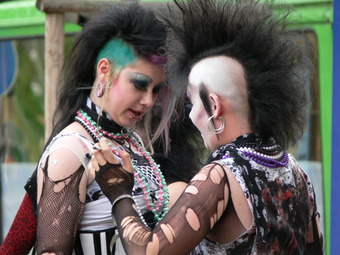
Clothing
How we choose to dress and style ourselves sends a message about us to the world.
Consequences
Nonverbal communication can have serious consequences, even if the public understands the message they are receiving is being conveyed unintentionally. For example, individuals tend to trust and support taller people. Obviously, an individual has no control over his height but, nevertheless, others perceive height to communicate certain character traits. In American elections, the taller candidate usually wins. In the 2004 presidential debates, George W. Bush (the shorter candidate) insisted that his podium be altered so that he appeared to be the same height as John Kerry. The point is that everything about ourselves, whether under our control or not, communicates information to an audience.

Nonverbal communication
One can tell that this couple is in love through nonverbal exchange. Obviously, the picture doesn’t talk, but from the couple’s posture, facial expressions, and clothing, one can tell that they’re getting married.
5.2.2: Exchange
Social exchange theory argues that people form relationships because they determine that it is in their best interests to do so.
Learning Objective
Explain how social exchange theory is based upon rational choice theory
Key Points
- In forming relationships, people exchange goods and services (including emotional support and interaction). People stay in relationships when they believe that the exchange is beneficial.
- Social exchange theory is rooted in rational choice theory.
- Individuals evaluate the worth of an action by subtracting the costs from the rewards.
Key Terms
- rewards
-
A gift given for positive reinforcement.
- Social Exchange Theory
-
It advances the idea that relationships are essential for life in society and that it is in one’s interest to form relationships with others. Of course, whether or not it is in an individual’s interest to form a relationship with a specific person is a calculus that both parties must perform.
- worth
-
It is having a value of; proper to be exchanged for.
Example
- A pro/con list is an example of the type of evaluative work that an individual must do when considering an action. Social exchange theory applies this type of equation to social relationships. As articulated by social exchange theory, individuals only stay in relationships when they determine that the exchange that will result from being in that relationship is worth the cost.
Social exchange theory is a sociopsychological and sociological perspective that explains social change and stability as a process of negotiated exchanges between parties. The theory is fundamentally oriented around rational choice theory, or the idea that all human behavior is guided by an individual’s interpretation of what is in his best interest. Social exchange theory advances the idea that relationships are essential for life in society and that it is in one’s interest to form relationships with others. Of course, whether or not it is in an individual’s interest to form a relationship with a specific person is a calculation that both parties must perform. Nevertheless, social exchange theory argues that forming relationships is advantageous because of exchange. Each party to the relationship exchanges particular goods and perspectives, creating a richer life for both. Notably, while social exchange theory may reference the literal exchange of goods, it can also mean the exchange of more intangible elements. For example, it is in the interests of a dairy farmer and a vegetable farmer to form a relationship because they can exchange their material goods. The theory also applies to Jack and Jill who decide to get married for the emotional support they exchange with one another.
Social exchange theory is only comprehensible through the lens of rational choice theory. Rational choice theory supposes that every individual evaluates his/her behavior by that behavior’s worth, which is a function of rewards minus costs. Rewards are the elements of relational life that have positive value for a person, while costs are the elements of relational life that have negative value for a person. Social exchange theory posits that individuals perform the calculus of worth when decided to form or maintain a relationship with another person. A good example of this would be proverbial “pro/con” list someone might make when deciding to stay or break up with her significant other.
Several assumptions undergird social exchange theory. The first is that humans seek rewards and avoid punishments. Second, humans are rational actors. Finally, social exchange theory acknowledges that the standards by which humans evaluate costs and rewards vary over time and from person to person. This means that what might seem rational to one person would seem completely irrational to another. However, so long as the individual’s decision-making regarding the formation of social relationships involves an evaluation of worth, regardless of what that means to the person, the behavior fits the frame established by social exchange theory.
5.2.3: Cooperation
Cooperation is the process of two or more people working or acting in concert.
Learning Objective
Compare the three types of cooperation (coerced, voluntary and unintentional) and why cooperation is necessary for social reality
Key Points
- Cooperation can be coerced, voluntary, or unintentional.
- Communication is necessary for cooperation.
- Cooperation derives from an overlap in desires and is more likely if there is a relationship between the parties.
Key Terms
- Coerced Cooperation
-
It is when cooperation between individuals is forced.
- Voluntary Cooperation
-
It is cooperation to which all parties consent.
- Unintentional Cooperation
-
It is a form of cooperation in which individuals do not necessarily intend to cooperate, but end up doing so because of aligning interests.
Example
- The legislature is an example of a cooperative act. If legislators did not cooperate with one another, no laws would get passed.
Cooperation is the process of two or more people working or acting together. Cooperation enables social reality by laying the groundwork for social institutions, organizations, and the entire social system. Without cooperation, no institution beyond the individual would develop; any group behavior is an example of cooperation. Cooperation derives from an overlap in desires and is more likely if there is a relationship between the parties. This means that if two people know that they are going to encounter one another in the future or if they have memories of past cooperation, they are more likely to cooperate in the present.
There are three main types of cooperation: coerced, voluntary, and unintentional. Coerced cooperation is when cooperation between individuals is forced. An example of coerced cooperation is the draft. Individuals are forced to enlist in the military and cooperate with one another and the government, regardless of whether they wish to. Voluntary cooperation is cooperation to which all parties consent. An example of voluntary cooperation would be individuals opting to complete a group project for school when given the option of a group project or an individual project. Unintentional cooperation is a form of cooperation in which individuals do not necessarily intend to cooperate but end up doing so because of aligning interests. The free hand of a capitalist economy is an example of unintentional cooperation, where individuals will take actions based on their own interests resulting sometimes in unintentional cooperation.
Communication plays an essential role in cooperation. Communication enables simple acts of cooperation by facilitating parties’ recognition that they have mutual interests and large acts of cooperation by organizing the masses. Without communication, individuals would not be able to organize themselves to cooperate.

Cooperation in Politics
Without cooperation, Congress would be unable to create any laws.
5.2.4: Conflict
Social conflict is the struggle for agency or power within a society to gain control of scarce resources.
Learning Objective
Discuss how various groups in society compete for resources, status and power within society, known as conflict theory
Key Points
- Conflict theory argues that conflict is a normal and necessary part of social interaction. In other words, conflict is seen as part of the social landscape rather than an anomaly.
- According to the theory, conflict is motivated by pursuit of personal interests. All individuals and groups are interested in gaining control over scarce resources, and this leads to conflict.
- Once one party gets control of resources, that party is unlikely to release them. The Matthew Effect is the idea that those in control will remain in control.
Key Terms
- Social Conflict
-
The struggle for agency or power within a society.
- Zero Sum Game
-
The idea that if group A acquires any given resource, group B will be unable to acquire it.
- Matthew Effect
-
The idea that those who have control will maintain control.
Example
- War is the quintessential example of conflict. During war, one army tries to gain control over available resources in order to prevent the opposing army from gaining control.
Social conflict is the struggle for agency or power within a society. It occurs when two or more people oppose one another in social interactions, reciprocally exerting social power in an effort to attain scarce or incompatible goals, and prevent the opponent from attaining them.
Conflict theory emphasizes interests deployed in conflict, rather than the norms and values. This perspective argues that the pursuit of interests is what motivates conflict. Resources are scarce and individuals naturally fight to gain control of them. Thus, the theory sees conflict as a normal part of social life, rather than an abnormal occurrence. The three tenets of conflict theory are as follows:
- Society is composed of different groups that compete for resources.
- While societies may portray a sense of cooperation, a continual power struggle exists between social groups as they pursue their own interests.
- Social groups will use resources to their own advantage in the pursuit of their goals, frequently leading powerful groups to take advantage of less powerful groups.
Conflict theory relies upon the notion of a zero sum game, meaning that if group A acquires any given resource, group B will be unable to acquire it. Thus, any gain for group A is automatically a loss for group B. Conflict theory further argues that group A will continue to search for resources in order to keep group B from getting them, leading to the exploitation of the powerless. The idea that those who have control will maintain control is called the Matthew Effect.
According to the principles of conflict theory, all cooperation is only for the purpose of acquiring individual or group resources. This motivation for behavior restructures day-to-day interactions among people in a given society.

War
War is the classic example of conflict: one army is attempting to maintain control of resources (land, weapons, morale) so that the other army cannot have them.
5.2.5: Competition
Competition is a contest between people or groups of people for control over resources.
Learning Objective
Explain how competition can be both a help and a hinderance for people in any particular society or group
Key Points
- People can compete over tangible resources, such as land, food, and mates, but also over intangible resources, such as social capital.
- Many evolutionary biologists view inter-species and intra-species competition as the driving force of adaptation and, ultimately, of evolution.
- Many philosophers and psychologists have identified a trait in most living organisms that can drive the particular organism to compete.
Key Terms
- innate
-
Inborn; native; natural; as, innate vigor; innate eloquence.
- evolution
-
gradual directional change, especially one leading to a more advanced or complex form; growth; development
Example
- .
Competition is a contest between people or groups of people for control over resources. In this definition, resources can have both literal and symbolic meaning. People can compete over tangible resources like land, food, and mates, but also over intangible resources, such as social capital. Competition is the opposite of cooperation and arises whenever two parties strive for a goal that cannot be shared.
Competition can have both beneficial and detrimental effects. Positively, competition may serve as a form of recreation or a challenge provided that it is non-hostile. On the negative side, competition can cause injury and loss to the organisms involved, and drain valuable resources and energy. Many evolutionary biologists view inter-species and intra-species competition as the driving force of adaptation, and, ultimately, of evolution. However, some biologists, most famously Richard Dawkins, prefer to think of evolution in terms of competition between single genes, which have the welfare of the organism “in mind” only insofar as that welfare furthers their own selfish drives for replication. Some Social Darwinists claim that competition also serves as a mechanism for determining the best-suited group–politically, economically, and ecologically.
Many philosophers and psychologists have identified a trait in most living organisms that can drive the particular organism to compete. This trait, unsurprisingly called “competitiveness,” is viewed as an innate biological trait that coexists along with the urge for survival. Competitiveness, or the inclination to compete, has become synonymous with aggressiveness and ambition in the English language. Just as advanced civilizations integrate aggressiveness and competitiveness into their interactions, as a way to distribute resources and adapt, most plants compete for higher spots on trees to receive more sunlight. However, Stephen Jay Gould and others have argued that as one ascends the evolutionary hierarchy, competitiveness (the survival instinct) becomes less innate and more a learned behavior.
The term also applies to econometrics. Here, it is a comparative measure of the ability and performance of a firm or sub-sector to sell and produce/supply goods and/or services in a given market. The two academic bodies of thought on the assessment of competitiveness are the Structure Conduct Performance Paradigm and the more contemporary New Empirical Industrial Organisation model. Predicting changes in the competitiveness of business sectors is becoming an integral and explicit step in public policymaking. Within capitalist economic systems, the drive of enterprises is to maintain and improve their own competitiveness.

Competitive Sport
All competitive sports are examples of competition for prestige.
5.2.6: Stereotypes in Everyday Life
A stereotype is a belief about a group of individuals that people apply to any given individual deemed to be part of that group.
Learning Objective
Evaluate the pros and cons of using stereotypes in society, such as understanding an individual based on common characteristics (pro) to racism (con)
Key Points
- Stereotypes are a heuristic, or tool, to help humans process an overwhelming amount of information as we try to learn about the world around us.
- Stereotypes enable the development of ingroups and outgroups, which can lead to the poor treatment of outgroups. If someone is perceived to be different from you, you might have an easier time treating them poorly. Stereotypes distinguish people.
- The universal application of a stereotype to every perceived member of a group is prejudicial.
Key Terms
- outgroup
-
It is a social group to which an individual does not identify.
- ingroup
-
It is a social group to which a person psychologically identifies themselves as a member
- heuristic
-
An experience-based technique for problem solving, learning, and discovery. Examples include using a rule of thumb or making an educated guess.
Examples
- A classic example of an us versus them mentality is the Holocaust. The Nazis configured the Jews, a stereotyped class, to be inhuman, allowing the Nazis to treat people they placed in that class inhumanely.
- An example of the poor logic of universal application is the following: it is a common stereotype that people who wear glasses are smart. Certainly, there are some glasses-wearing, intelligent people. But it is poor logic to think that everyone who sports glasses is intelligent.
A stereotype is a belief about a group of individuals that people apply to any given individual whom is deemed to be part of that group. Stereotypes are usually inaccurate in their universal application. This means that although some individuals within a given group may fit a stereotype, others most certainly will not. The error in stereotyping is the application of a preconception to everyone who is perceived to belong to a particular group.
Stereotypes as Heuristics
Stereotypes are useful for the human brain because they operate as a heuristic or a cognitive mechanism to quickly gather, process, and synthesize information. As social animals, we seek to gather information about those around us. However, there is too much information to process in its entirety. Therefore, we have heuristics to make the process more efficient. In applying a stereotype, one is able to quickly “know” something about an individual. For example, if the only thing you know about Katherine is that she belongs to a band, you are able to guess that she likes music. People use stereotypes as shortcuts to make sense of their social contexts; this makes the task of understanding one’s world less cognitively demanding.
Us Verus Them
By dividing the world into discrete categories by stereotyping, one is able to foster an us versus them mentality. This view separates the social world into different categories and distinguishes others from oneself. In other words, the creation of an us versus them mentality divides the world into an ingroup and an outgroup. An ingroup is the group with which one identifies; an outgroup is everyone else. In line with the reasoning that describes heuristics, distinguishing oneself from others is a cognitively necessary step; it allows us to develop a sense of identity. However, an us versus them mentality fostered by stereotyping can be used to justify horrible treatment of an outgroup. Once one feels as though someone else belongs to an outgroup, one has less difficulty treating that individual inhumanely. A classic example of an us versus them mentality is the Holocaust. The Nazis configured the Jews, a stereotyped class, to be inhuman, allowing the Nazis to treat people they placed in that class inhumanely.
Stereotypes and Prejudice
Given the social and cognitive necessities of heuristics, the problem with stereotyping is not the existence of the cognitive function. The problem lies in the assumption that all people of a group—a group with which they might not even identify—are the same. For example, it is a common stereotype that people who wear glasses are smart. Certainly, there are some glasses-wearing, intelligent people. But it is poor logic to think that everyone who sports glasses is intelligent. Stereotyping can lead to prejudice, or negative perceived judgements about a group of people. The application of prejudice to a given individual can cause personal and social damage.
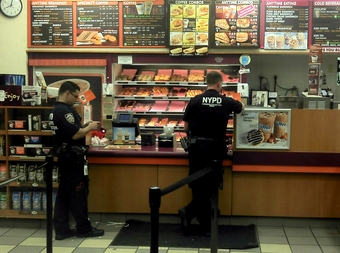
Stereotyping of Police Officers
Police officers buying donuts and coffee is a popular stereotype of officers in the United States.
5.2.7: Personal Space
Personal space is the region surrounding people that they regard as psychologically their own.
Learning Objective
Explain how the use of personal space can convey social relationships between people in various cultures
Key Points
- In general, the more intimate the relationship, the closer one is able to go into another’s personal space. Negotiating these boundaries reflects on social proximity.
- Sociologists study personal space precisely because of social implications of distance in regard to relationships.
- Senses of personal space are culturally defined. Those who live in urban areas tend to require less personal space, for example. People in Western culture have different notions of personal space than people elsewhere.
Key Term
- personal space
-
The physical space closely surrounding a person, which, if encroached upon, can lead to discomfort, anger or anxiety.
Example
- An example of the cultural determination of personal space is how urbanites accept the psychological discomfort of someone intruding upon their personal space more readily than someone unused to urban life. Living in the city alters the development of one’s sense of personal space.
Personal space is the region surrounding people that they regard as psychologically theirs. Most people value their personal space and feel discomfort, anger, or anxiety when that space is encroached. Permitting a person to enter personal space and entering somebody else’s personal space are indicators of how the two people view their relationship. There is an intimate zone that is reserved for lovers, children, and close family members. There is another intermediary zone that is used for conversations with friends, to chat with associates, and in group discussions. There is a further zone that is used by strangers and acquaintances, and finally, a zone that is used for public speeches, lectures, and performances.
The size of one’s sense of personal space is culturally determined, in addition to being dependent upon the nuanced relationship of the two interlocutors. Averaged estimates place one’s sense of personal space at two feet on either side, 28 inches in front, and 16 inches behind for an average Westerner. Those living in densely populated places tend to have a smaller sense of personal space. Moreover, individual sense of space has changed historically as the notions of boundaries between public and private spaces have evolved over time.
Senses of personal space are intimately tied to the relationship between the two individuals involved. Entering someone’s personal space is normally seen as an indication of familiarity. However, in modern society, particularly in crowded urban communities, it is sometimes difficult to maintain personal space; for example, in a crowded train. Many people find such physical proximity to be psychologically uncomfortable, but it is accepted as a fact of modern life. Sociologists study personal space precisely because of social implications of distance in regard to relationships.
5.2.8: Eye Contact
Eye contact develops in a cultural context and different gazes have different meanings all over the world.
Learning Objective
Discuss the various ways people use eye contact as a means of social and emotional expression
Key Points
- Eye contact is an incredibly expressive form of nonverbal communication.
- Eye contact aligns with the relationship underlying the gaze. People who are close with one another look at each others eyes; avoiding eye contact can put distance between two individuals.
- The customs and significance of eye contact vary widely between cultures, with religious and social differences often altering its meaning greatly. For example, Japanese children are taught to direct their gaze at the region of their teacher’s Adam’s apple or tie knot.
Key Terms
- eye contact
-
The condition or action of looking at another human or animal in the eye.
- oculesics
-
The study of eye contact as a form of body language.
Example
- Eye contact provides a read of the social relationship between the two people involved in the gaze. For example, lovers will gaze into each other’s eyes. Conversely, people wanting to put distance between themselves and others on a crowded subway will not look at the other passengers.
Eye contact is the meeting of the eyes between two individuals. In humans, eye contact is a form of nonverbal communication and has a large influence on social behavior. The study of eye contact is sometimes known as oculesics.
Eye contact provides a way in which one can study social interactions, as it provides indications of social and emotional information. People, perhaps without consciously doing so, probe each other’s eyes and faces for signs of positive or negative mood. In some contexts, the meeting of eyes arouses strong emotions. Eye contact can establish a sense of intimacy between two individuals, such as the gazes of lovers or the eye contact involved in flirting. Alternatively, avoiding eye contact can establish distance between people. When in crowds, people tend to avoid eye contact in order to maintain privacy.
The customs and significance of eye contact vary widely between cultures, with religious and social differences often altering its meaning greatly. According to the tenets of the Islamic faith, Muslims ought to lower their gazes and try not to focus on the features of the opposite sex, except for the hands and face. Japanese children are taught to direct their gaze at the region of their teacher’s Adam’s apple or tie knot. As adults, Japanese tend to lower their eyes when speaking to a superior as a gesture of respect. In Eastern Africa, it is respectful not to look the dominant person in the eye, whereas such avoidance of eye contact is negatively interpreted in Western cultures. As with all forms of social interaction that impart social significance, eye contact is culturally determined.
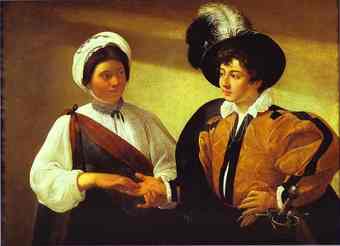
Eye Contact in Painting
Two figures lock eyes in Caravaggio’s The Fortune Teller.
5.2.9: Applied Body Language
Body language is a crucial part of social interaction.
Learning Objective
Discuss the importance of body language as a means of social communication and give specific examples of body language
Key Points
- Research has suggested that between 60 and 70 percent of all meaning is derived from nonverbal behavior.
- One basic body-language signal is when a person crosses his or her arms. When the overall situation is amicable, it can mean that a person is thinking deeply about what is being discussed, but in a serious or confrontational situation, it can mean that a person is expressing opposition.
- Flirting is an example of applied body language. Sexual or romantic interest is primarily communicated through body language, which may include flicking one’s hair, eye contact, brief touching, open stances, and close proximity between partners.
Key Terms
- Flirting
-
It is a playful activity involving verbal communication and also body language to indicate an interest in a deeper romantic or sexual relationship.
- body language
-
Nonverbal communication by means of facial expressions, eye behavior, gestures, posture, and the like; often thought to be involuntary.
Example
- Flirting is an example of applied body language.
Body language is a form of human non-verbal communication, which consists of body posture, gestures, facial expressions, and eye movements. Humans send and interpret such signals almost entirely subconsciously. It is impossible for social scientists to study body language in any manner that is not applied. Indeed, social scientists are interested in body language precisely because of what it conveys about social interactions and the relationship between nonverbal interlocutors. This dynamic can only be studied in applied contexts.
Research has suggested that between 60 and 70 percent of all meaning is derived from nonverbal behavior, making body language a crucial part of social interaction. Body language may provide clues as to the attitude or state of mind of a person. For example, it may indicate aggression, attentiveness, boredom, relaxed state, pleasure, amusement, and intoxication, among many other clues.
One of the most basic and powerful body language signals is when a person crosses his or her arms across the chest. This can indicate that a person is putting up an unconscious barrier between themselves and others. However, it can also indicate that the person’s arms are cold, which would be clarified by rubbing the arms or huddling. When the overall situation is amicable, it can mean that a person is thinking deeply about what is being discussed, but in a serious or confrontational situation, it can mean that a person is expressing opposition. This is especially so if the person is leaning away from the speaker. A harsh or blank facial expression often indicates outright hostility.
Another obvious example of expressive body language used in everyday life is flirting. Flirting is a playful activity involving verbal communication and also body language to indicate an interest in a deeper romantic or sexual relationship. Flirting usually involves speaking and behaving in a way that suggests a mildly greater level of intimacy than the actual relationship between parties would justify, though within the rules of social etiquette, which generally frown upon a direct expression of sexual interest. Body language may include flicking one’s hair, eye contact, brief touching, open stances, and close proximity between partners. Thus, by watching two individuals, one can tell if they are flirting.

Marilyn Monroe
Marilyn Monroe has been described as the ultimate flirt. Does this photograph fit that perception? Does it have anything to do with her body language?
5.3: Elements of Social Interaction
5.3.1: Social Status
Social status refers to one’s standing in the community and his position in the social hierarchy.
Learning Objective
Discuss the basis of both ascribed and achieved social status and how they influence one another and a person’s standing within different groups of society
Key Points
- Social status may be achieved (earned) or ascribed (assigned at birth).
- Both achieved and ascribed statuses influence one another.
- Social mobility allows an individual to move between social levels in the general social hierarchy.
- Max Weber suggests that social status is the confluence of property, prestige, and power.
- Pierre Bourdieu argues that social status is a combination of economic and social capital, which combine to produce a difference of social “tastes” that are decided by class.
- Pierre Bourdieu argues that social status is a combination of economic and social capital, which combine to produce a difference of social “tastes” that divide by class.
Key Terms
- hierarchy
-
Any group of objects ranked so that everyone but the topmost is subordinate to a specified group above it.
- Pierre Bourdieu
-
A twentieth century French sociologist who developed the notion of social capital.
- prestige
-
A measure of how good the reputation of something or someone is, or how favorably something or someone is regarded.
Example
- Whenever there is any form of society, one sees social status come into play. A primary example of social status within a confined community would be the negotiation of social status in high school and the types of statuses that are ascribed to various archetypes such as the jock, the nerd, the theater kid, etc.
Social status refers to the honor or prestige attached to one’s position in society. It may also refer to a rank or position that one holds in a group, such as son or daughter, playmate, pupil, etc. One’s social status is determined in different ways. One can earn his or her social status by his or her own achievements; this is known as achieved status. Alternatively, one can inherit his or her position on the social hierarchy; this is known as ascribed status. An ascribed status can also be defined as one that is fixed for an individual at birth, like sex, race, and socioeconomic background.
Social status is most often understood as a melding of the two types of status, with ascribed status influencing achieved status. For example, a baby born into a high-income household has his family’s high socioeconomic status as an achieved status and is more likely to be exposed to resources like a familial emphasis on education that will make it more likely for him or her to get into an elite university. Admission, therefore, is an achieved status that was heavily influenced by resources made available by the person’s ascribed status.
It is easy to see how achieved and ascribed statuses accumulate into the social status of an individual. Pulling back into a larger perspective, these same factors accumulate into a system of social stratification. Social stratification is a conceptual social hierarchy in which individuals are ranked in terms of their perceived value to society. In capitalist countries, this hierarchy is largely socioeconomic, in that high-income individuals are ranked at the top of the social hierarchy with low-income individuals at the bottom. However, social stratification is not limited to economics; perceived moral value is also integrated into the stratification so that a poor member of the clergy is in a higher social rank than a rich criminal.
Social status, or the social sphere in which one belongs, can be changed through a process of social mobility. One can move either up or down the social hierarchy and the process is described in terms of upward or downward mobility. Simply, social mobility allows a person to move into a social status other than the one into which he was born depending upon one’s ambition, lack thereof, or other factors.
One’s social status depends on the context of a his or her situation and is therefore malleable. Take, for example, an employee who works on the floor of a manufacturing company. When considered in light of the larger social hierarchy, this worker will probably fall somewhere toward the mid-bottom of the hierarchy because of his socioeconomic status. Yet, perhaps this man is the floor manager and therefore has control of hundreds of other employees. When he’s at his place of work, he is high on the ladder of social hierarchy.
Social status has been theorized by major sociologists, including Max Weber . Weber was a prominent German social theorist in the late nineteenth and early twentieth centuries. Weber proposes that there are three primary components to social stratification: property, prestige, and power. Property refers to one’s material possessions and subsequent life chances. Prestige refers to the reputation or esteem associated with one’s social position. Weber uses power to mean the ability to do what one wants, regardless of the will of others. These “three P’s” combine to produce social stratification.
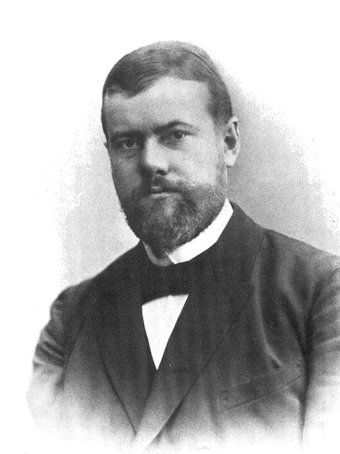
Max Weber
Max Weber and Wilhelm Dilthey introduced verstehen—understanding behaviors—as goal of sociology.
Twentieth century French sociologist Pierre Bourdieu continued to theorize social status . According to Bourdieu’s 1979 work Distinction, social capital is just as significant a factor in social status as economic capital. By this, Bourdieu means that indicators of one’s class are not limited to how much money one has in the bank, but also one’s cultural tastes which one acquires beginning in his youth. These tastes are influenced by class. For example, tastes for classical music and foie gras would typically signal an upbringing from a higher social class than one whose tastes are for Cheetos and Top 40 hits. Thus, social stratification is demonstrated by economic class and the cultural preferences that it engenders.

Pierre Bourdieu
According to Bourdieu’s 1979 work Distinction, social capital is just as significant a factor in social status as economic capital.
5.3.2: Role Theory
Role theory argues that human behavior is guided by expectations held both by the individual and by others in the community.
Learning Objective
Explain how the development and fulfillment of particular roles within society (both occupational and relational) relates to a person’s behavior
Key Points
- A role is a set of rules or norms that function as plans or blueprints to guide behavior within a particular society.
- Roles can be occupational or relational. An occupational role relates to a person’s individual function (for example, a profession). A relational role governs how the individual behaves towards others (for example, being a father or a boss).
- Role theory is structural functionalist in that it seeks to explain human behavior by looking at what social function is fulfilled by holding a given role.
- Role theory suggests that a substantial proportion of observable, day-to-day behavior is simply people carrying out roles and negotiating which role to prioritize. Once you understand someone’s role and which of their many roles they are prioritizing, you can predict how they are going to behave.
Key Terms
- abuse
-
Physical or verbal maltreatment; injury.
- self-neglect
-
It refers to behaviors that threaten the person’s own health and safety.
Examples
- Examples of roles include father, mother, son, brother, sister, friend, girlfriend, boss, CEO, employee, and secretary. All of these “titles” incorporate social and individual expectations for behavior.
- An example of social theory is that a boss behaves in a particular way because society expects her to and she has similar expectations of her own conduct.
- An example of how social roles are created in response to changing identity politics is the elaboration of the “disability role. ” In recent years, disabled individuals have formed better-connected communities. As these communities have strengthened, a conversation about the role disabled individuals fill in society at large has emerged.
A virtual world is an online community that takes the form of a computer-based simulated environment through which users can interact with one another. Individuals create online representations of themselves called avatars that can interact on the internet under direction of the avatar’s creator. Such modeled worlds and their rules may draw from reality or fantasy worlds. Example rules are gravity, topography, locomotion, real-time actions and communication.
Social interaction between users can range from communication via text, graphical icons, visual gesture, sound, touch, voice command, and balance senses. Many MMORPGs (massively multiplayer online role-playing games) have real-time actions and communication. Players create a character who travels between buildings, towns and worlds to carry out business or leisure activities. Communication is usually textual, but real-time voice communication is also possible.
Many studies of virtual worlds have questioned the virtual world’s ability to convey nuanced emotional messages as people do in face-to-face interactions. Certainly, users have developed techniques in the virtual world to communicate emotion. Beyond writing messages, users can communicate using emoticons, or simple “smilies” that visually depict simple emotions. While emoticons obviously do not convey the same range of mixed emotions as a human face, it is clear that participants in virtual worlds are innovating with language and images to develop new forms of communication.
Another aspect of social interaction in virtual worlds is variation of interactions between participants. While interaction with other participants in virtual worlds can often be done in real-time, time consistency is not always maintained in online virtual worlds.
Although the social interactions of participants in virtual worlds are often viewed in the context of online games, other forms of interaction are common. These include forums, wikis, chat rooms and video-conferences. Communities are born which have their own rules, topics, jokes and even language. Members of such communities can find like-minded people to interact with, whether this be through a shared passion, the wish to share information, or a desire to meet new people and experience new things.
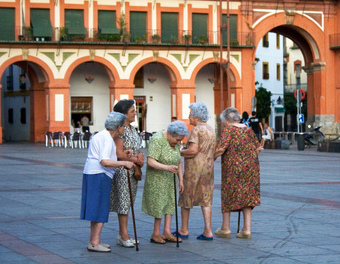
Elderly Women Gathering
This image shows that elderly people can be active, social, and in good spirits.
5.3.3: Role Conflict
Role conflict describes the conflict between or among the roles corresponding to two or more statuses held by one individual.
Learning Objective
Interpret how role conflict affects an individual’s perception of him/herself and his/her place within society
Key Points
- We experience role conflict when we find ourselves pulled in various directions as we try to respond to the many statuses we hold.
- The most common form of role conflict is work/family conflict, in which one needs to prioritize familial or professional obligations.
- The effects of role conflict are related to individual personality characteristics and interpersonal relations.
Key Terms
- role conflict
-
A conflict between or among the roles corresponding to two or more statuses in one individual.
- work/family conflict
-
A conflict one faces when one must choose between family needs and work obligations.
Example
- An example of someone experiencing role conflict by way of work/family conflict is the professional who is also a parent and must decide whether to work an extra hour at the office or attend a meeting at his child’s school.
Role conflict describes a conflict between or among the roles corresponding to two or more statuses fulfilled by one individual. We experience role conflict when we find ourselves pulled in various directions as we try to respond to the many statuses we hold.
The most obvious example of role conflict is work/family conflict, or the conflict one feels when pulled between familial and professional obligations. Take, for example, a mother who is also a doctor. She likely has to work long hours at the hospital and may even be on call several nights a week, taking her away from her children. Many individuals who find themselves in this position describe feeling conflicted and distressed about their situation. In other words, they experience role conflict.
The above example is presented as a personality role conflict: The woman is torn between the part of her personality that values being a mother and the part that identifies as being a doctor. For an example of interpersonal relations causing role conflict, consider an individual who is a school superintendent and a father. He might think that his wife and children expect him to spend most of his evenings with them, but he may also feel that his school board and parents’ groups expect him to spend most of his after-office hours on educational and civic activities. He is therefore unable to satisfy both of these incompatible expectations, and role conflict is the result .
Conflict among the roles begins because of the human’s desire to reach success, and because of the pressure put on an individual by two imposing, apposing and incompatible demands competing against each other. The effects of role conflict, as found through case studies and nationwide surveys, are related to individual personality characteristics and interpersonal relations. Individual personality characteristic conflicts can arise when “aspects of an individual’s personality are in conflict with other aspects of that same individual’s personality. “
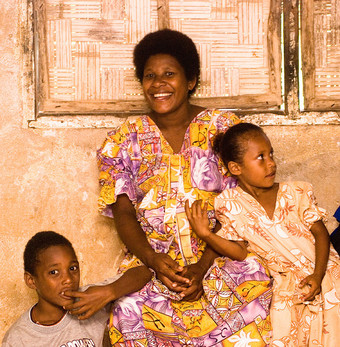
Family Taught Gender Roles
5.3.4: Culture
Culture is the set of beliefs, values, symbols, rituals, fashions, etiquette, foods, and art that unite a particular society.
Learning Objective
Analyze how culture is defined, materially and symbolically
Key Points
- Culture elements are learned behaviors; children learn them while growing up in a particular culture as older members teach them how to live. As such, culture is passed down from one generation to the next. This process of learning culture is called “acculturation”.
- Culture can be studied either through material or symbolic cultural forms.
- Biology and learned experiences influence one another to create cultural norms.
- Culture provides the rules for behaviors and patterns of thought in social life.
- Ethnocentrism is the tendency to view the world primarily from the perspective of one’s own culture and tends to place different culture’s below one’s own.
- Cultural relativism insists that no culture is better or worse than any other, only different.
Key Terms
- nature versus nurture debate
-
The nature versus nurture debate concerns the relative importance of an individual’s innate qualities (“nature,” i.e., nativism, or innatism) versus personal experiences (“nurture,” i.e., empiricism or behaviorism) in determining or causing individual differences in physical and behavioral traits.
- acculturation
-
A process by which the culture of an isolated society changes on contact with a different one, especially a more advanced society.
Culture is the set of beliefs, values, symbols, means of communication, religion, logics, rituals, fashions, etiquette, foods, and art that unite a particular society. Culture elements are learned behaviors; children learn them while growing up in a particular culture as older members teach them how to live. As such, culture is passed down from one generation to the next. This process of learning culture is called “acculturation. “
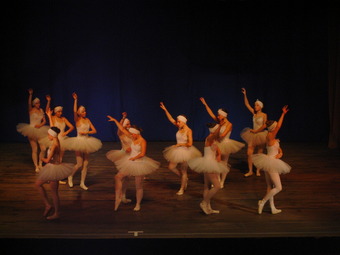
High culture
Ballet is traditionally considered high culture.
One way of understanding culture is to think of the nature versus nurture debate. In this debate, social scientists asked whether nature or nurture is more influential in human life. Nature was considered to be things like our biology and genetics, while nurture was considered to be learned behaviors and other environmental influences on our identities. In this debate, culture is lumped together with the nurture side because both include learned behaviors and systems of thought that we pick up on from our surroundings. To illustrate the nature versus nurture debate, think of any human being. That person’s genetic material and physical body is what is considered his nature. But anything that the person does falls in the nurture side of the debate. This includes how he dresses, what he eats, what language he speaks, and every way in which he behaves.
While the nature versus nurture debate is useful to understand what culture is, the debate in academia has been somewhat settled by the acknowledgement that nature and nurture influence each other. Biology gives us the neural capacity for things like language and culture, but our environments teach us how to use these capacities. For example, biology enables humans to learn a language; this makes us different from other species. However, nothing about our biology dictates whether a baby learns English, Spanish, or Tagalog. Which language one speaks is a learned behavior. Likewise, our cultural behaviors influence our biology. For example, before 4000 BCE, the gene that creates a protein that allows for the digestion of lactose was present in babies for consuming their mothers’ milk, but then that protein would disappear after a baby was weaned. In 4000 BCE, humans began to domesticate animals and continue to drink their milk even after infancy. As such, over generations of using this cultural practice of animal domestication, the gene mutated to continue to produce the protein in adulthood. Thus, over time, the cultural practice influenced human biology. Nature and nurture contribute to one another.
In sum, culture provides the rules for behaviors and patterns of thought in social life. Because culture is learned, it is necessarily an aspect of social life and, therefore, requires a society or a group of people who interact and engage with one another. One way of thinking of a culture is the group of people to whom a set of symbols is understandable. For example, a rectangle with 13 alternating red and white stripes and a set of 50 white stars set on a blue patch in the upper left corner might not mean anything to someone in Greenland. To most Americans, the described design is an American flag, which itself connotes national pride.
It is tempting to associate a particular society with a particular country, but this isn’t always the case. Certainly, some symbols (like flags) are understandable within a particular country, but it is important to consider dissent and subcultures. Culture can be difficult to pinpoint and individuals within a given culture might disagree over what their culture is. Culture is both unifying and contentious.
Culture spreads through material and symbolic means, each demanding different methodologies and techniques to study. Material culture consists of the goods used to exhibit particular cultural behaviors. One could say that coffee cups, laptops, sweatshirts, and pizza are elements of the material culture of life on a college campus. Cultural anthropologists and sociologists use material culture to understand a culture at large and archaeologists use digs to reveal the material culture of the past in order to learn more about life in that culture. Symbolic culture consists of the belief systems that found and motivate life in a particular culture. Well circulated stories about a college’s founding, which professors are good to take classes with, and the college’s motto are all elements of the symbolic culture of a university. Both types of cultures can spread between different societies, in this case, different college campuses.
5.3.5: Social Class
Social class is a measure of where a particular person falls on the social hierarchy.
Learning Objective
Summarize the concept of social hierarchy as related to the development of social class
Key Points
- A social hierarchy refers to the arrangement of people in society, with some people having more power and others having less.
- Max Weber evaluated an individual’s social class by a measure of power, property, and prestige.
- Social class is typically thought of in a three-class model, dividing a population into upper, middle, and lower classes.
- In the United States, very few people are in the upper class, but the upper class possesses a disproportionate amount of the nation’s wealth.
Key Terms
- social facts
-
the values, cultural norms, and social structures which transcend the individual and are capable of exercising a social constraint
- Three-Class Model
-
It includes the “rich,” the “middle class,” and the “poor. “
- White Collar Workers
-
The term white-collar worker refers to a person who performs professional, managerial, or administrative work, in contrast with a blue-collar worker, whose job requires manual labor. Typically white collar work is performed in an office or cubicle.
- socioeconomics
-
The branch of economics that deals with social aspects.
Example
- A recent example of social class coming to the fore in American politics is the Occupy Wall Street Movement. In September 2011, members of the middle and lower classes began to protest and set up temporary encampments next to Wall Street in New York City, the center for American banking and financial life. The occupiers were protesting American financial and social policy that privileged the upper class, even though the upper class contains a very small percentage of the population. “We are the 99%” became the protestors’ rallying cry, drawing attention to how small of a percentage of the population (1%) controls so much of the financial and political power in America. Within weeks, the movement had spread to cities around the world. The popularity of the Occupy movement demonstrates the reality of class conflict and significance of one’s social class in today’s society.
A social hierarchy refers to the arrangement of people in society, with some people having more power and others having less. Social hierarchies, also referred to as social stratification, largely refers to socioeconomics, or the amount of material and social capital that an individual possesses. However, the socioeconomic classification is a stand-in for the amount of power possessed by an individual. Thus, one can layer and categorize individuals and classify them by group according to how much social power they possess.
Social class is the layer or social stratum denoting socioeconomic power into which an individual falls. In other words, social class describes how people are differentiated based upon their wealth or power. In the late eighteenth century, class came to replace such categories as estates, rank, and orders as the primary means of organizing society into hierarchical divisions. This corresponded to a general decrease in the significance ascribed to hereditary characteristics and an increase in the significance of wealth and income as indicators of position in the social hierarchy. While hereditary characteristics, such as being born into a wealthy family, continue to influence the ease with which one establishes adult social standing, the model that emphasizes class and achieved status maintains the status quo in capitalistic societies, particularly the United States.
The study of social class and hierarchies fundamentally asks questions about inequality. Sociology has a long history of studying stratification and teaching about various kinds of inequality, including economic inequality, racial and ethnic inequality, and gender inequality. Inequality means that people have unequal access to scarce and valued resources in society, such as health care, education, jobs, property, housing, and political influence. Sociologists study the causes and effects of inequality.
As such, sociologists pay particular attention to socioeconomic status, as it signifies an equation of power and wealth that denotes a particular form of inequality. Late-nineteenth and early-twentieth century German social theorist Max Weber proposed that socioeconomic status was configured by a combination of power, property, and prestige. For Weber, power refers to an individual’s ability to impose his will on others, regardless of their wishes. Property refers to the sum total of one’s possessions in addition to their income. Property therefore goes beyond income as a measure of social class because it measures accumulated wealth in addition to one’s earning potential. Prestige refers to the reputation or esteem associated with one’s position in society. Prestige used to be associated with family name, but now more frequently is yoked to occupation. Occupations like physicians or lawyers tend to hold more prestige than bartenders or janitors.
Power, prestige, and property tend to go hand in hand. An individual who is born into a wealthy family is likely to be born with more property and have access to better educational resources to achieve prestige, culminating in more power. Yet this is not always the case. For example, a professor may have little property, but has high prestige. Conversely, a “trust-fund baby” or someone left family money, might have much property, but little prestige in a society that values personal achievement.
Social class is commonly organized into a three-class model, by which individuals are separated into upper, middle, and lower classes. The upper class consists of the wealthy and powerful individuals who own and control the means of production. In the United States, the upper class is comprised of the richest 1-2% of the country, but other countries, particularly in Europe, still emphasize aristocracy and the family into which one was born. The middle class is the broadest swath of society, consisting of professional workers, small business owners, and low-level managers. These people are also referred to as “white collar workers. ” The lower class consists of people who work wage jobs rather than salaried positions. Referred to as “blue collar workers,” the lower class has little economic security and includes both individuals working lower-paying positions and unemployed and/or homeless people.
Social class in the United States looks a little bit different than one might suppose given the three-class model. Consider the following facts: Four hundred Americans have the same wealth as the bottom 50% of Americans combined. Twenty-five Americans have a combined income almost as great as the combined incomes of two billion of the world’s poor. In 2007, CEOs in the top American companies received an average salary of $10.5 million per year, 344 times the pay of the average worker. Half of American children will reside in a household that uses food stamps at some point in their childhoods. As you can see, the upper class in the United States contains very few Americans; the population is concentrated in the middle and lower classes. Yet, the few people in the upper class control a disproportionate amount of American wealth.
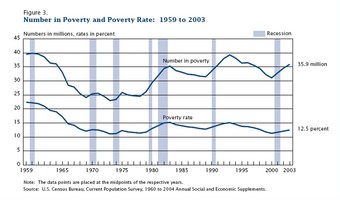
U.S. Poverty Rate 1959-2009
This chart depicts the number of people living in poverty during each year from 1959-2003. The poverty rate corresponds to what proportion of Americans live in the lowest economic strata of the hierarchical class system.
5.3.6: Groups
Groups are collections of people who identify and interact with one another and are united in some way.
Learning Objective
Discuss how heuristics allow people to learn about people within a society based on group affiliation and give examples of both positive and negative heuristics
Key Points
- Groups can be united by shared interests, values, language, backgrounds, social roles, or family ties.
- Group identification is one way that individuals make assumptions about others’ identities.
- Groups operate as cognitive heuristics. Heuristics are sometimes perceived to be legitimate assumptions about an individual and sometimes deemed illegitimate. Legitimate heuristics tend to just be those that import positive generalizations to a particular person.
- Group affiliation is negotiated. Sometimes an individual will protest an assumed group affiliation. Other times, a group will contest an individual’s claim to membership.
Key Terms
- Legitimate Heuristic
-
Generally, a heuristic that imports positive generalizations to a particular person.
- stereotype
-
A conventional, formulaic, and oversimplified conception, opinion, or image of a group of people or things.
- heuristic
-
An experience-based technique for problem solving, learning, and discovery. Examples include using a rule of thumb or making an educated guess.
Example
- Families, clubs, companies, classes, and teams are all examples of groups. A profession, such as a law enforcement, is not a group but a category. However, law enforcement officials who work in the same station and regularly meet and work together would be considered a group.
A social group is a collection of people who identify and interact with one another. They are united in some way, meaning that they may share interests, values, language, backgrounds, social roles, or family ties.
Perceiving society as a composite of groups allows for one to generalize about a particular person. If you know something about which groups a particular person belongs to, you may import certain character traits to that particular individual. In this way, groups operate as a cognitive heuristic, meaning that people use groups as a shortcut to use generalized information to learn about a particular person. If you know that Johnny is a member of the Computer Geek Club, you will assume that Johnny likes computers. Thus, you use group identity to generalize and make assumptions about a specific individual. Heuristics are sometimes perceived to be legitimate assumptions about an individual and sometimes deemed illegitimate. Legitimate heuristics tend to just be those that import positive generalizations to a particular person. For example, if you know that Sue holds an undergraduate degree, you may assume that Sue is an educated individual. However, the same heuristic can function in negative ways; this is the underlying mechanism that enables stereotypes. Stereotyping is when one makes generalizations about a particular person in a negative way based on their perceived group identity. Racism is one example of this; making assumptions about an individual because of their racial background is an example of negative group heuristics and stereotyping. Both legitimate and illegitimate heuristics demonstrate how knowledge about one’s group affiliations conveys perceived social knowledge about that individual.
In this way, a person’s group affiliation is associated with that person’s identity. The relationship between identity and politics is dynamic and contested. Sometimes a person is perceived to be part of a group to which they identify, such as when someone makes assumptions about another person’s identity based on their racial background. Conversely, an individual may claim membership to a group that rejects the petition. Take, for example, Elizabeth Warren’s 2012 campaign for the United States Senate. In public remarks, Warren declared that she had Native American heritage and was part Cherokee. However, many Cherokee individuals protested the declaration and insisted that Ms. Warren was not Cherokee until she could prove otherwise. By this, one can see how groups can serve as an interface between an individual and society at large.

Elizabeth Warren
Senate candidate Elizabeth Warren claimed membership to Native American groups in her 2012 campaign, raising questions about what it means to belong to a group.
5.3.7: Social Institutions
An institution is any structure or mechanism of social order governing the behavior of a set of individuals within a given community.
Learning Objective
Discuss how the development of social institutions, both formal and informal, acts a guide for the rules and expectation of people within society
Key Points
- Institutions can either be formal, in that they are designed to govern behavior, or informal, in that they govern behavior by socialization rather than overt practices.
- Institutionalization refers to the process of embedding something, such as a concept, a social role, a value, or a logic within an organization, social system, or society as a whole.
- Institutions can also be abstract, such as the institution of marriage.
Key Terms
- Formal Institutions
-
They are those that are created with the intention of governing human behavior.
- Informal Institutions
-
They are those that are not designed to regulate conduct, but often end up doing so as members seek to conform to communal standards.
An institution is any structure or mechanism of social order and cooperation governing the behavior of a set of individuals within a given community. Institutions are identified with a social purpose and permanence, transcending individual lives and intention by enforcing rules that govern cooperative behavior. While institutions are obviously comprised of individuals and create rules through these individuals’ agentic actions, institutions act as forces of socialization, meaning that they teach individuals to conform to their norms.
Institutions can be either formal or informal. Formal institutions are those that are created with the intention of governing human behavior. Examples include the United States Congress, an institution that is designed to create the laws of the United States. However, formal institutions do not have to have the force of the law at their disposal. Another example is the Roman Catholic Church. While violating the tenets of the Catholic Church is not in violation of law, the Church expects its members to adhere to its religious codes. Informal institutions are those that are not designed to regulate conduct, but often end up doing so as members seek to conform to communal standards. Institutions can also be abstract, such as the institution of marriage. This means that marriage has become a social expectation, with informal rules for how married people are expected to behave.

Formal institutions
The United States Congress, housed in the Capitol Building, is one example of a formal institution.
While institutions tend to appear to people in society as part of the natural, unchanging landscape of their lives, sociological studies of institutions reveal institutions a social constructs, meaning that they are created by individuals and particular historical and cultural moment. Sociology traditionally analyzes social institutions in terms of interlocking social roles and expectations. Social institutions are created by and defined by their own creation of social roles for their members. The social function of the institution is the fulfillment of the assigned roles.
Institutionalization refers to the process of embedding something, such as a concept, a social role, a value, or a logic within an organization, social system, or society as a whole. The process of institutionalization elucidates how values, norms, and institutions are so closely intertwined.
5.3.8: Social Networks
A social network is a social structure that exists between actors—individuals or organizations.
Learning Objective
Assess the role of social networks in the socialization of people
Key Points
- A social network is comprised by various nodes and the ties that connect them.
- Nodes can be individuals or organizations.
- Ties are the various types of connections these nodes. Ties are assessed in terms of strength. Loose connections, like mere acquaintances, are called weak ties. Strong ties, like family bonds are called strong ties.
- The study of networks is called either social network analysis or social network theory.
- The small world phenomenon is the hypothesis that the chain of social acquaintances required to connect one arbitrary person to another arbitrary person anywhere in the world is generally short. The concept gave rise to the phrase “six degrees of separation” after Stanley Milgram’s 1967 experiment.
Key Terms
- Ties
-
They are the various types of connections between nodes.
- node
-
They are the individual actors within the networks, and ties are the relationships between the actors.
- Social Network Analysis
-
It is the study of social networks
Example
- Facebook is an example of a large social network. This example demonstrates the difference in strong and weak ties. If all of your friends are nodes in your Facebook social network, how many of your connections are strong ties? How many are weak ties? How does the difference in whether the tie is strong or weak both reflect and impact between you and the friend represented by the other node?
A social network is a social structure that exists between actors—individuals or organizations. A social network indicates the way that people and organizations are connected through various social familiarities, ranging from casual acquaintance to close familial bonds. Social networks are composed of nodes and ties. The person or organization participating in the network is called a node. Ties are the various types of connections between these nodes. Ties are assessed in terms of strength. Loose connections, like mere acquaintances, are called weak ties. Strong ties, like family bonds are called strong ties.
Shape and Size
The shape and size of social networks influence their utility for their nodal participants . Smaller, tighter networks composed of strong ties behave differently than larger, looser networks of weak ties. The looser and larger the network, the more likely nodes are to introduce new ideas and opportunities to their members. Participants in smaller networks are more likely to share values and information, increasing efficiency, but decreasing creativity.

Diagram of a Network
Individuals in groups are connected to each other by social relationships.
Small World Phenomenon
The small world phenomenon is the hypothesis that the chain of social acquaintances required to connect one arbitrary person to another arbitrary person anywhere in the world is generally short . The concept gave rise to the famous phrase “six degrees of separation” after a 1967 small world experiment by psychologist Stanley Milgram which found that two random US citizens were connected by an average of six acquaintances.
The study of social networks is called either social network analysis or social network theory. Research has indicated that social networks operate on many levels—from familial to national—and play a critical role in determining the ways that problems are solved, the way organizations are run, and the degree to which individuals succeed in achieving their goals. Social network theory argues that individual traits and characteristics usually presumed to have significance actually matter far less than an individual’s relationship and ties to other actors in a network. Critics argue that this perspective diminishes the power and agency of the individual. Despite these criticisms, sociologists study social networks because of their influence on individuals. Social networks are seen as the basic tool individuals use to connect to society.
5.3.9: Virtual Worlds
A virtual world is an online community that takes the form of a computer-based simulated environment through which users can interact.
Learning Objective
Explain how virtual worlds are changing the face of societal interactions, such as through the development of new language and like-minded communities
Key Points
- Such modeled worlds and their rules may draw from reality or fantasy worlds. Social interaction between users can range from communication via text, graphical icons, visual gesture, touch, voice command, and balance senses.
- Researchers have questioned the virtual world’s ability to convey nuanced emotional messages in face-to-face interactions. That said, participants in virtual worlds are innovating with language and images to develop new forms of communication like emoticons.
- Another aspect of social interaction in virtual worlds is variation in interactions between participants. While the interaction with other participants in virtual worlds can often be done in real-time, time consistency is not always maintained in online virtual worlds.
Key Terms
- Virtual World
-
It is an online community that takes the form of a computer-based simulated environment through which users can interact with one another.
- emoticon
-
A graphical representation, either in the form of an image or made up of ASCII characters, of a particular emotion of the writer.
- avatar
-
The physical embodiment of an idea or concept; a personification.
Example
- Virtual worlds include multiplayer games like World of Warcraft and social networking sites like Facebook. Further, virtual worlds can emerge when people who know each other in reality engage virtually through online messaging services like AOL Instant Messenger and Google Chat.
A virtual world is an online community that takes the form of a computer-based simulated environment through which users can interact with one another. Individuals create online representations of themselves called avatars that can interact on the internet under direction of the avatar’s creator. Such modeled worlds and their rules may draw from reality or fantasy worlds. Example rules are gravity, topography, locomotion, real-time actions and communication.
Social interaction between users can range from communication via text, graphical icons, visual gesture, sound, touch, voice command, and balance senses. Many MMORPGs (massively multiplayer online role-playing games) have real-time actions and communication. Players create a character who travels between buildings, towns and worlds to carry out business or leisure activities. Communication is usually textual, but real-time voice communication is also possible.
Many studies of virtual worlds have questioned the virtual world’s ability to convey nuanced emotional messages as people do in face-to-face interactions. Certainly, users have developed techniques in the virtual world to communicate emotion. Beyond writing messages, users can communicate using emoticons, or simple “smilies” that visually depict simple emotions. While emoticons obviously do not convey the same range of mixed emotions as a human face, it is clear that participants in virtual worlds are innovating with language and images to develop new forms of communication.
Another aspect of social interaction in virtual worlds is variation of interactions between participants. While interaction with other participants in virtual worlds can often be done in real-time, time consistency is not always maintained in online virtual worlds.
Although the social interactions of participants in virtual worlds are often viewed in the context of online games, other forms of interaction are common. These include forums, wikis, chat rooms and video-conferences. Communities are born which have their own rules, topics, jokes and even language. Members of such communities can find like-minded people to interact with, whether this be through a shared passion, the wish to share information, or a desire to meet new people and experience new things.
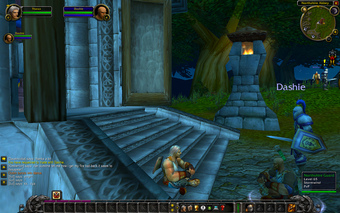
World of Warcraft
This is a still from World of Warcraft, a popular online game in which players direct avatars who interact with one another.
